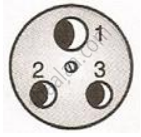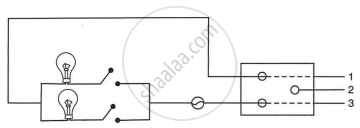Advertisements
Advertisements
Question
Fig shows a three pin plug top. Label the three pins. Why is the top pin thicker and longer than the other two? Why are the pins splitted at the ends?

Solution
E is for earth pin, N is for neutral pin and L is for live pin.
The earth pin is long so that the earth connection is made first. This ensures the safety of the user because if the appliance is defective, the fuse will blow off. The earth pin is made thicker so that even by mistake it cannot be inserted into the hole for the live or neutral connection of the socket.
The pins are splitted at the ends to provide spring action so that they fit in the socket holes tightly.
APPEARS IN
RELATED QUESTIONS
Identify the following wires used in a household circuit: The wire is connected to the top terminal of a three pin socket.
What purpose is served by the terminals of a three way pin plug? Draw a diagram and name the pins.
Draw a labelled diagram of a three pin socket.
The following diagram shows a three pin socket marked as 1, 2 and 3.

- Identify and write live (L) neutral (N) and earth (E) against the correct number.
- To which part of the appliance is the terminal 1 connected?
- To which wire joined to 2 or 3, is the fuse connected?
In following Figure shows two bulbs with switches and fuse connected to mains through a three pin socket by means of a three wires cable.

- Label each component - bulb, switch, fuse and socket.
- Name and state the colour of insulation of each wire 1, 2 and 3.
- How are the two bulbs joined: in series or in parallel?
Name the markings of a three-pin plug. Give the colour codes of the connecting leads.
State the purpose served by the terminals of a three pin plug.
Draw diagram of a three pin socket outlet and state the connections made to them.
Draw a diagram of a three pin plug top. Mark the pins used for live, neutral and earth connections as L, N and E respectively. To which part of the appliance is the pin marked as E connected. To which line L or N is the fuse connected?
